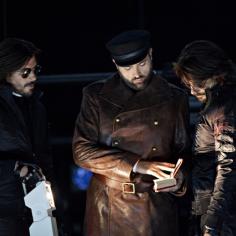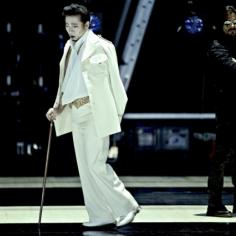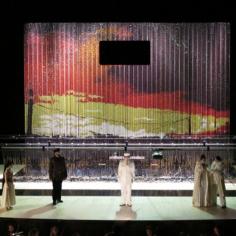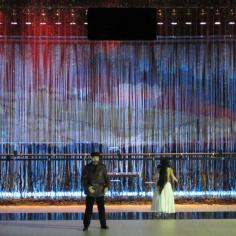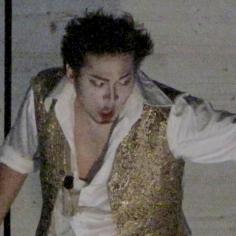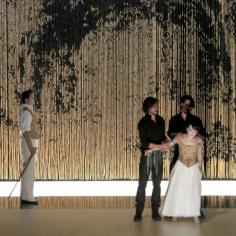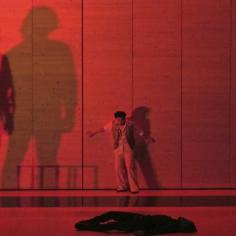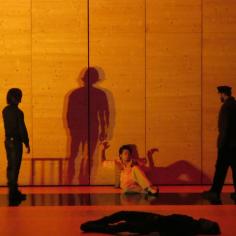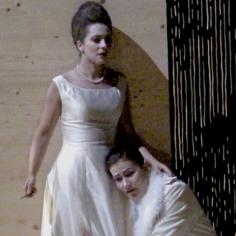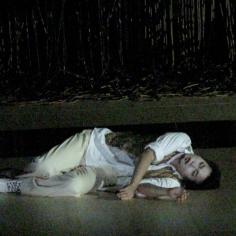2013 · Orlando (EN)
"There is no such thing as an innocent spectator. What you see inevitably has a history, a more or less real past. Abstract art plays on the idea that the spectator takes part in the event both bodily and with his memory. When body and memory become involved in a work of art, something happens - something changes."[1]
With HAENDEL's opera ORLANDO, ÉRIC VIGNER invites us to delve into the inner landscape of a man whose frenzy is the furor of a man devoid of strength. The hero is bloodless, fettered by the pain of a lost love that borders on mental derangement.
"Orlando is the alienated story of a Ulysses who, exhausted by an overly long voyage home, has lost the love of his Penelope."
BÉNÉDICTE VIGNER
With its excellent cast - DAVID DQ LEE (Orlando), ADRIANA KUCEROVA (Angelica), KRISTINA HAMMARSTRÖM (Medoro), SUNHAE IM (Dorinda), LUIGI DE DONATO (Zoroastro) and the actors GRÉGOIRE and SÉBASTIEN CAMUZET - this lyrical variation on the personage of Orlando celebrates the renewed encounter of conductor JEAN-CHRISTOPHE SPINOSI and director ÉRIC VIGNER (L’ILLUSION COMIQUE, 1996 and MARION DE LORME, 1998).
Recalling the original characters
"Why has Orlando been turned into a character out of a Baroque pastoral idyll? To obliterate him? To deny his enraged derangement? To try to make something different out of this ancient story of fighting and heroism? What I like about this opera is this story of an experience. Producing something artistically means subjecting somebody to a series of experiences - something that comes close to a performance."[2]
FRÉDÉRIC BOYER
"Approaching opera as one would perhaps try to come to grips with a dream, one of those dreams which hover, once you are awake, like a puzzling, persistent emotion whose unknown origins you strive to unveil."[3]
"As in Corneille's L'Illusion comique, written a century earlier, it is by way of the theatre that Orlando - an effeminate hero who is but a distant cousin of Ariosto's Orlando furioso - is to be exposed to the experience of love. The place at which he experiences this love is the theatre. HAEndel's opera is the musical landscape, the setting in which Orlando passes through the different stages of love - longing, love, passion, jealousy, despair, scorn, and madness resulting in an attempted suicide mark the different stages of this initiation. Just as the libretto seems a far cry from Ariosto's epic, its characters appear first and foremost like memories of an ancient myth: the heroes are tired, and indeed the very concept of heroes is no longer valid, since love is given preference over warfare. But then, love is dangerous, as Zoroastro demonstrates only too well. Like Fellini, he engineers a love scheme where Orlando, Angelica, Medoro and Dorinda find themselves lost, caught in the snares of light-hearted banter (à la Marivaux). The amorous discourse of the protagonists is reflected in the aesthetics of the mise-en-scène: the stage becomes an irreal, insecure place where our lovers may well unveil - or lose - themselves. By choosing to represent music as a work of art that cannot be given concrete form - on the model of "Brancusi contre Etats-Unis", where I posed the question of the role of art in the field of theatre - I have continued and extended this aesthetic reflexion whose object it is to enhance the lyrical quality of the ceremonial."
ÉRIC VIGNER
"Scenography is a catalyst capable of transforming space in order to endow matter with a magical, surreal presence that imparts to the spectator a more physical and intuitive understanding of the matter in hand."[4]
Éric Vigner’s twilight opera
"There is nothing dusty about this baroque opera, Orlando is still a modern character. His fleetness of foot, tempered by a slight limp, affords a glimpse of the fragility of his haughty courage, which is falling prey to untimely outbursts of love. A magician warns him that his beloved has fallen in love with another man. Heartbroken, he flees into timelessness. The stage design gives concrete form this timeless space, depicting an endless night, a kind of stage labyrinth with no perceptible entrance or exit. Like Orlando, who would rather drift aimlessly on the waves of love and its illusions than face up to his glory-crowned destiny, we remain immobile, paralysed by the realistic wind of contemporaneity. Indeed, it is exactly by way of this immobilising bulwark that Éric Vigner attracts his audience. The actors, rendered almost statuesque by their costumes and the wealth of symbols that envelop them, come to life, and inordinately so, by means of a repertoire of gestures of excessive theatricality. This is what makes the trials and tribulations of love and the stirrings of the heart so delightful. Voices resound through the night of their inertia, resplendent as though they were the most infallible guides for their passions. These voices, of countertenors and sopranos, are like luminous threads that interweave and wind around the pain of human passions, thousands of fragile apperceptions that weave a sparkling, glittering costume. The voices turn celestial, incarnated and enlivened by the Ensemble Matheus, a virtuosic orchestra conducted by Jean-Christophe Spinosi. Step by step, the music infiltrates the scene, taking possession of the ear, and, whenever it holds its breath, casting a dazzling light on HAEndel’s creative genius. A mystical experience that leaves you detached, naked, free from any fetters, to set out on a journey to the very limits of human emotions."
QUENTIN MARGNE, Inferno Magazine, 8 January 2014
All in all, love is but a folly, according to sages from all parts of the world. Even though not all those affected by it become raving mad like Orlando, their mental distraction becomes apparent in other ways. What clearer evidence could there be found than destroying oneself in response to the will of another?[5]
"Éric Vigner creates an abstract universe of great visual elegance. In this space, the product of pure artifice, Zoroastro, by snapping his fingers, conjures up a forest, or an ocean, merely by means of a marvellous curtain of coloured beads. The various states of mind of the protagonists change this landscape whenever one of the actors moves the curtain, just as emotions change our view of the world around us."
Tania Bracq, Forum Opéra, 18 October 2013
For the first time in Brittany, three major cities and their institutions have joined forces to create an opera of prestigious quality: L’Opéra de Rennes, Le Quartz à Brest and Le Théâtre de Lorient, with the support of the Regional Council and the DRAC. This bundling of energies has enabled the project to find additional partners outside the confines of Brittany, viz. L'Opéra royal du Château deVersailles and the Théâtre du Capitole de Toulouse.
[2] FRÉDÉRIC BOYER, author of RAPPELER ROLAND, talks with ÉRIC VIGNER, TDL Magazine
[3] MICHEL POIZAT, L'OPÉRA OU LE CRI DE L'ANGE, Éditions Métailié 2001
[4] Ketevan Kintsurashvili, International Symposium on Scenography, Praha 2011
[5] ARIOSTO, ORLANDO FURIOSO (O.F. XXIV, 1-3), Éditions Garzanti, Milano 1992
© Photographies : Alain Fonteray, Jean-Louis Fernandez
Texts assembled by Jutta Johanna Weiss
Translation from the French by Herbert Kaiser
© CDDB-Théâtre de Lorient
